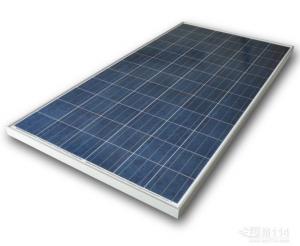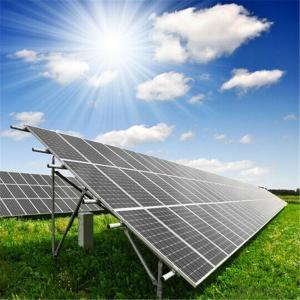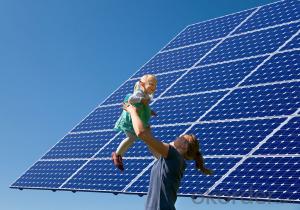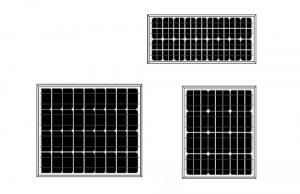Best and Cheapest Mono-Crystalline Solar Modules & Panels 270W
- Loading Port:
- China Main Port
- Payment Terms:
- TT or LC
- Min Order Qty:
- -
- Supply Capability:
- -
OKorder Service Pledge
OKorder Financial Service
You Might Also Like
1.Structure of Solar Module Description
A solar cell module of the present invention was made to improve adhesion between electrodes, which is formed with thermosetting resin containing silver paste, of a solar cell element and connecting tabs coated with lead (Pb) free solder. To achieve this purpose, the solar cell module is comprised of a front surface member, a rear surface protective member, a plurality of solar cell elements provided between the front surface member and the rear surface protective member, and connecting tabs for electrically connecting the solar cell elements to each other through electrodes with the use of lead free solder. The electrodes of the solar cell elements are made of silver paste containing thermosetting resin and silver powder. The thermosetting resin contains epoxy resin at volume ratio of 70% or more having a glass transition rate of 80° C. to 200° C. measured by a TMA method. The connecting tabs coated with lead free solder are soldered to the electrodes.
2.Main Features of the Solar Module
Solar PV module is comprised of some solar cells which are connected in serial with high efficiency and enhanced reliability. The solar cells are laminated between sheets of ethylene vinyl acetate (EVA) and high-clarity low-iron tempered glass.
Solar panel pv module manufacturer
High efficiency: mono panel 18% poly panel 17%
30W-300W mono solar panel poly solar module
Mono-crystalline Solar Panel / Poly-crystalline Solar Panel
We Are Manufacturer
We manufacture mono solar panel and poly solar panel from 30W-300W
We produce Solar PV module from solar cell to solar module
We are capable to produce 2MW solar panels per month
Warranty
5 years material and workmanship warranty
10 years at 90% of the minimal rated power output
25 years at 80% of the minimal rated power output
3.Solar Module Images


4.Solar Module Specification
Specifications
Electrical Spec. | Pmax | 240W |
Vmp | 35V | |
Imp | 6.86A | |
Voc | 43V | |
Isc | 7.77A | |
Physical Spec. | Cell Material | Poly |
Wind Resistance | 60m/s | |
Surf. Load-bearing | 200kg/m2 | |
Hail Load-capacity | 25mm, 80km/h | |
Packaging Data | Dimensions (mm) | 990*1600*35 |
Weight | 25kg | |
20’ Container | 224pcs | |
40’ Container | 448pcs | |
Temp. Coefficients (TC) | NOCT | 45°C±2°C |
Current TC | 0.06±0.01%/K | |
Voltage TC | -(155±10)mV/K | |
Power TC | -(0.5±0.05)%/K |
Product Details
Advanced EVA encapsulation system with triple-layer back sheet meets the most stringent safety requirements for high-voltage operation
Anodized aluminum frame: The sturdy, anodized aluminum frame allows the modules to be mounted on a variety of standard racking systems and to withstand harshest conditions
Ultra reliable bypass diodes prevent damage through overheating due to shaded or defective cells
Packing method: Innovative, environmentally friendly packing method using pile-edges insures modules arrive in perfect condition
New frame design incorporating hexagonal shaped Drainage holes, with more grounding holes, provide flexible installation and using
Waterproof Battery Box
Waterproof battery box, ideal for high humidity area
Air-bleed vent design, specially for gel and lead acid battery
High strength: PVC plastic box and wire reinforced PVC conduit
5.FAQ of Solar Module
1. Q: Do you have your own factory?
A: Yes, we have. Our factory located in Jiangyin city, jiangsu province.
2. Q: How can I visit your factory?
A: Before you take off from your country, please let us know. We will show you the way,or arrange time to pick you up if possible.
3. Q: Do you provide free sample?
A: Usually we do not offer free sample
4. Q: Could you print our company LOGO on the nameplate and package?
A: Yes, we can do that.
5. Q: Do you accept custom design on size?
A: Yes, if the size is reasonable.
- Q: can a small solar panel be charged with lamps?
- That would depend on the frequency that the solar panel accepts and the frequency of light that your lamp gives out. It may or may not work. The sun gives out a much broader spectrum of light, which is why solar panels are much more effective in sunlight. I have seen solar panels charged by lamps, but it usually doesn't work that well and I have never seen it work with fluorescent lighting.
- Q: I want to use this solar panel to hook up AC adapters. IM not sure what to do and how to use the solar panel. I want to be able to use a batter charger, a radio, and charge a GPS if needed. - Thanks, Zoo
- Research using solar panels on stock tank water pumps. Same concept - you use a solar panel to power a remote something or other, only you would have to use a battery charged by day to run the camera at night. It does not look like you would need too powerful of a solar panel, the camera server says it needs less than 5w, no idea on the cameras, so check that out, but the whole system looks rather low power. You could easily get the necessary panels, maybe the battery too, for... I would say $200 (not in one package, you would have to get separate things). Connection of everything would be simple, no electrician needed (but keep that to yourself, depending upon state rules and regs).
- Q: Are there any aesthetic considerations when installing solar panels?
- Yes, there are aesthetic considerations when installing solar panels. The design and placement of solar panels should be mindful of the overall appearance of the building or property. Factors such as panel color, size, orientation, and integration with the existing structure are important to ensure that the solar panels blend well with the surroundings and do not compromise the visual appeal of the property.
- Q: I want to be more green and if I get the panels will I still have a regular electric bill?
- There okorder / Why pay thousands of dollars for solar energy ($27,000 average cost) when you can build your own solar panel system for just a fraction of the retail cost. You can build a single solar panel or you can build an entire array of panels to power your whole house. Some people are saving 50% on their power bill, some people are reducing their bill to nothing. But what’s most impressive is that just by following these instructions some are even making the power company pay them!
- Q: How Much energy does Solar Panel Produce,and How long can Solar Panels go without maintenance.
- Solar panels are available in a wide variety of power ratings.? Energy is the sum of power over time, so how much energy a panel produces depends on the intensity of the light hitting it and how long it's applied. I understand that current single-crystal silicon PV panels are warranted to produce ~85% of their rated output for 25 years.? Most will do better, and will produce useful output for perhaps 50 years or more.
- Q: I'm going to pitch an idead to my school about switching to Solar Energy. What are positive and negative effects of the solar panels?Also what is the cost for installing them into a highschool?How much would the electricity bill decline afterwards?
- If you hope to get a solar panel that can run appliances and air conditioning.. then you are not even close to being realistic about what solar panels can do. If you really want to install a solar panel array on your home, then you need to talk to a company in your area that designes and installes them because every installation is different.. so you won't get an answer here on Yahoo. You can expect to spend $20,000 to $30,000 that will provide enough solar power for the average home.
- Q: Are photovoltaic cells the same as solar panels?
- Yes, they are the same thing.
- Q: Heard you can put solar panels on laptops Anyone know if it can work on a Dell mini 0v? I've seen he USB slot solar pana but can someone tell me where to gt these?
- That strikes me as completely impractical for most circumstances. The power output of your mains adapter is 30W and to do that you are looking at at least five or six square feet of solar panels costing in the region of $600 even from a surplus supplier I know. You could do it cheaper (maybe $50 on panels) but then you would be looking a more primitive panels and need perhaps thirty square feet of solar panels. This is a completely different exercise to creating a solar powered USB charger - the power requirement is a lot higher. Astronomy and space?
- Q: how would you build a solar panel
- As a sandwich. Glass Space /4 inch Glass Space with copper radiator painted flat black. Box made of wood. with the inside painted black. Insulate the back side. Use water with RV antifreese. Circulate water through with a small pump. Face it toward the sun. Thermal water solar Panel.
- Q: Can solar panels be installed on wineries or vineyards?
- Yes, solar panels can be installed on wineries or vineyards. In fact, many wineries and vineyards around the world have adopted solar energy systems to power their operations and reduce their carbon footprint.
Send your message to us
Best and Cheapest Mono-Crystalline Solar Modules & Panels 270W
- Loading Port:
- China Main Port
- Payment Terms:
- TT or LC
- Min Order Qty:
- -
- Supply Capability:
- -
OKorder Service Pledge
OKorder Financial Service
Similar products
Hot products
Hot Searches
Related keywords


























